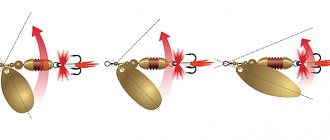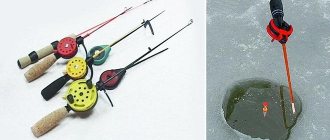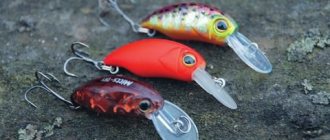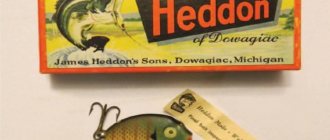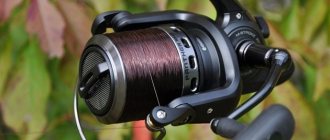Types of pike spoons and their features
In the modern world there is a wide variety of lures for pike, but real fishermen always have a spinner in their arsenal, since pike are caught with it all year round.
Spoons for pike are divided into two main classes:
- Oscillating spinners.
- Rotating spinners.
Oscillating spoons or short oscillators are made of a metal plate in a slightly curved form, and when inserted, they begin to waddle, move from side to side, in a word, oscillate, hence their name. Oscillating spoons are popular because they have a number of advantages:
- universal spinner. You can use it both in calm bodies of water and in strong currents;
- used in hard to reach places. The spoons provide little resistance, as they have the shape of a curved plate, so you can catch pike with it even in the most inaccessible places;
- ease of use. Using this spinner, you don’t need any skills, you just need to throw the spinning rod and pull it towards you, the spinner itself will begin to “play” in the water.
Rating of oscillating lures for pike in the video below:
A spinner or simply a spinner consists of a wire rod, a metal petal, which rotates around the center (rod) when retrieved, and a treble hook. Turntables also have several advantages:
- ease of use. Even a beginner can handle such a spinner; no knowledge is needed;
- vibrations created. The appearance of the spoons is not similar to any other fish, therefore it is the vibrations created that attract the pike.
Photo: Spoons for pike and their varieties
Unhooked
There is another type of spinner - non-hooking. This lure is designed in such a way that during the retrieve the hooks are hidden and open only during the bite. Many experienced fishermen are wary of non-hook baits, as they believe that this spoon makes a lot of empty hooks. However, it still has its advantage - fishing for pike in hard-to-reach places, for example among dense thickets, shallow water, and wetlands.
Popular manufacturers of spinners
Spoons take an active part in fishing. If you buy a low-quality lure, you can really regret it. So that you don’t have any problems choosing manufacturers, we will share with you the 5 best manufacturers of spinners and their prices, so that you can know approximately how much their products cost.
- Canadian Williams spinners. These spoons are popular because they have perfect play in the water and a natural shine that pike loves so much. The main distinguishing feature of Williams spinners is that they are made of high quality brass and coated with precious metals - silver and gold. Who would have thought that such a combination would become popular in the fishing market. Such spinners can be bought for a very reasonable price, from 300 to 1500 rubles.
- Mepps (Meps) - French-made spinners. The company has been on the market for more than 80 years, during which time it has earned itself an excellent reputation. Most anglers choose Mepps spinners and appreciate them for the quality, play and shine of the spinners. Prices for these spoons start from 90 rubles.
- Atom. Legend of domestic fishing. The company appeared in the 50s of the last century and still exists. Spinner spoons from this manufacturer are valued for their range, catchability and inexpensive prices. Almost every third angler has an Atom spinner. Anyone can afford such working spinners, because their prices are very low, starting from 50 rubles.
- Rapala spinners from a Finnish manufacturer. The company’s entire product range consists of almost one spinner – Rapala Minnow Spoon (Rapala RMS). This spoon is notable for the fact that it consists of plastic and has one hook, which is protected from snags. You can buy a spinner for around 260-600 rubles.
- Kuusamo (Kuusamo) is a Finnish manufacturer of spinners. These lures differ in the production process. They are completely handmade and go through 13 stages of painting. But besides this, they attract attention with their sophisticated oscillating game, luring the pike more and more. Prices for this manufacturer range from 300 to 800 rubles.
About
Spoon color
For fishing in ponds with muddy water, you should use bait with a high level of shine. At the same time, it is important not to overdo it, using too bright spoons, which will create glare in the water and rather scare away the fish than attract them.
For fishing in clear water, an excellent solution would be matte spoons, the surface of which is detailed with fish scales.
Always take all your lures with you when fishing; it is impossible to know for sure what the fish will bite on today.
How to choose a lure for pike
As we have already said, pike can be caught all year round; therefore, it is better to choose a spoon according to the seasons, because each season has its own nuances.
- Summer is not the peak of activity. In summer, the most effective fishing will be with a rotating spoon. Another important nuance for a good catch is that in very hot weather the spoons should be slightly smaller. The best spinner size in summer starts from 5 cm in length, but if you want to catch a larger pike, you can take a bait 10-15 cm long.
- Autumn is the peak of activity. During this period, the pike tries to gain weight and fat for the winter. In the fall, it can be caught with any type of spinner; as for the size, there is a high probability of catching fish with large spinners, from 10 cm in length. The bait should be applied in steps or evenly, perhaps even with pauses.
- Winter is low activity. During this period, the pike leads a passive lifestyle. Therefore, when catching it, most likely you will have to wait a long time for the result. It is better to make holes in places where the bottom is heterogeneous (pits, currents). The optimal spinner size is 5-10 cm.
- Spring - increased activity. During this period, the pike will not quickly chase the prey, so it is better to move the bait slowly. Vibrators 5-8 cm long are best suited.
About
Top 10 best lures for pike
We have already talked to you about the best manufacturers, now it’s time to choose the best spinners that will easily and quickly catch pike.
Mepps Aglia Long №3
A fairly simple spoon, but it has the ability to attract large pike. A simple holographic sticker on the petal allows you to quickly attract the fish's attention. This spoon is in demand among fishermen due to its price, dimensions (you can catch both large and small fish), and reliable design.
Kuusamo Professor 3
This spoon has a double hook, which is hidden under the antennae, which protect the spoon from accidental snags. Experienced fishermen prefer this model, as it provides the best performance for catching pike in both open and hard-to-reach places. In addition, Kuusamo Professor 3 has a high-quality coating that can last 5 seasons.
Kuusamo Rasanen
This model consists of 2 classes. The first is 5 cm long and weighs 11 grams and contains a hanging double with a rivet and a well-balanced mustache. And the second is 6 cm long and weighs 15 grams, contains a red bead, which helps to make an even greater impression on the predator.
Williams Wabler
Has 7 different models within one series. The advantage lies in the variety of choice, multi-aspect movement, which depends on the size of the spoon. The Williams Wabler bait has established itself among experienced fishermen as one of the best lures for pike.
RB Atom-N
One of the most catchy spinners. Many people love it for its versatility, it works well with any retrieve, and thanks to the shifted center of gravity, the spoon makes soft and wave-like movements. The best inexpensive and working spinner, proven over the years.
Rapala Minnow Spoon
Has good maneuverability in overgrown, inaccessible places. The effectiveness of this spinner was confirmed by Era! magazine, which conducted a test among its readers. This model took first place in this study, so it has the right to take a place in our ranking.
Mepps Black Fury
Another catchy lure for pike. Incomparable appearance, ideal color combination, durable construction, low price, all this is ideally combined in this model. Such an abundance of colors when the petal rotates will definitely attract the attention of your prey.
About
Types of spinners
There are no universal baits that work equally successfully in any body of water, at any water temperature and in any weather. Different fishing conditions and different bodies of water may have their own catchable lures, which may behave completely differently on another day or in another place. The main types of pike lures include spoons, spinners and non-snooks.
Oscillating spinners
The shape of the body of this bait is made in such a way that the spinner makes low-frequency oscillatory movements from side to side during the retrieve. Vibrators are made exclusively from metal. The vibrator can have different sizes and weights, be polished or painted in one or more colors. There are also relief baits.
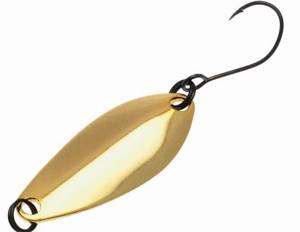
Oscillating spoons create small vibrations in the water
Turntables
Despite the fact that a spinner is considered a perch bait, pike are often tempted by it. The thing is that in the process of movement, the petal of the bait, rotating, creates noise in the water, which attracts fish to itself. The pike hears this noise at a distance of 10-20 m. Mostly small pike take to the turntables, but bites happen more often than to the spinner. The pinwheel should have an angle of inclination of its petal of about 60-70 degrees.

Spinner spoons are good for catching small pike
Non-hooking spinners
When fishing in rivers overgrown with grass or snags, the likelihood of the bait being caught increases. In this case, it is better to use non-hooking pike spoons. Their design includes special antennae raised above the hook. They allow the lure to successfully avoid obstacles. Sometimes the hook is hidden inside the bait itself if it is large enough. Such fishing lures can be carried from the very shore without fear of snagging on reeds or grass. Often such postings are accompanied by attacks by pike waiting for prey near thickets of aquatic vegetation.
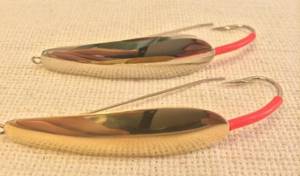
Non-hooking spinners have special antennae
How does the color of the spoon affect pike fishing?
It has been noticed that the color of the spoon plays an important role in catching a predator. Water has different colors at different times of the year and in different bodies of water. Therefore, the spinner should look as natural as possible in it:
- In clear water, a dark bait may be more catchy, and in muddy water, a brighter one.
- In sunny weather, try to avoid shiny coatings that scare away fish.
- If the water has a dark tint, but is transparent, then copper and gold shades will have an advantage.
- If you prefer to catch pike at depth, you should know that when diving to 5 m, the spoon looks darker. And at depths of more than 10 m, pike distinguishes only blue and green colors.
- Sometimes a predator prefers colored baits with unnatural colors, which are rarely found in nature. However, when "pure" metal doesn't work, they often come to the rescue.
- It is beneficial to use baits that combine several colors. They may unexpectedly turn out to be the most catchy.
In any case, pike fish better on those colors that correspond to the colors of small fish living in a particular body of water.
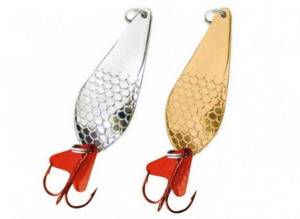
Use bright lures if fishing in murky waters
Dependence of bite intensity on the size of the spoon
The probability of catching a predator largely depends on the size of the spoon. For example, it is useless to catch large fish with a small spoon, which it may simply not notice. But a large spoon more successfully imitates a sick fish moving smoothly along the bottom. The length of the spoon must correspond to the actual size of the small fish that pike feed on in a given reservoir. Usually it is 3-12 cm. The width does not matter much, but an unnaturally wide bait can make the fish suspicious.
In summer, when there is an abundance of algae in the water, large spoons often get entangled and therefore cannot provide high-quality play. During this period, it is recommended to use small baits.

If there is a lot of algae in the pond, then take small spoons
What should the weight of the spinner be?
The farther you plan to cast the bait, the greater its weight should be. The speed of the current is also taken into account. So, when fishing for pike on a river with a strong current, a lure that is too light will be carried away by the current, not giving it the opportunity to sink to depth.
How to make a lure for pike with your own hands
They started making pike lures on their own back in the USSR; the manufacturing process was not hidden from anyone, but on the contrary, skills and abilities were shared. All these ideas have reached us, so now we will share with you the secret of how to make a spinner yourself.
To make a spinner you will need:
- tablespoon;
- file;
- hammer;
- nail;
- hook;
- winding rings.
Once we have prepared all the tools, we begin manufacturing:
- It is necessary to cut off the handle of the spoon.
- Next, we process the cut area with a file.
- We drill small holes along the edges on both sides.
- Now we install the hook in one of the holes, and the winding rings in the other.
That's all, our spoon bait is ready. Many spinning anglers praise these homemade pike spoons for good catching of prey. The entire manufacturing process is shown in more detail in the video below:
The most important thing in pike fishing is the right choice of spoon. If you want to return home with your catch, thoroughly study the types of spoons, choose the right spoon for fishing, taking into account all the nuances that we have discussed with you. Have a nice catch everyone. And as they say, no tail, no scales!
Views: 3,135
Similar articles:
- The most catchy spinners for pike. Top 10 spinners Don't get carried away by the wide variety of spinners, just a few spinners are enough...
- Pinwheels for pike. Top 10 most catchy Spinners like “Mepps” are one of the most effective baits...
- Catching pike in the fall with a spinner I don’t know how right I am, but it seems to me that a spinning rod...
- Catching pike with a spoon Fishing for pike with a spoon is an exciting and challenging business...
How to properly lure and catch pike
As is already clear from the content of the material, trolling methods differ in their execution depending on the gear and fishing method. Spinning fishing is carried out in open water, making horizontal movements. Oscillating spoons are cast in several ways, using a uniform and jerky technique. In turn, uniform drives differ in the parameters of their speed characteristics, and jerk drives differ in the intensity of pauses.

In spring and summer, pike love slow and medium bait feeds. In autumn, the speed can be increased to the limit. Fishing for pike with lures in the fall is characterized by feeding bait from the bottom. That is, after casting, the spinner is allowed to lie on the bottom and after a pause, the animation begins with a jerk. In other periods, the fish likes to pick up bait at the beginning of its move in the water column. They catch fish near the wall of vegetation and in places of bottom anomalies, regardless of the depth, only balancing this parameter by selecting the weight of the bait.
Non-hooking methods are similar to conventional oscillators. They are mainly used for catching pike in the fall, in snags and underwater dead wood. Spinners are rotated in the spring at a fast pace, trying to keep the accessory in the water column. In autumn and summer, pike love spinners launched at the bottom at a slow speed. One of the contradictions of summer fishing with spinners is this negative factor, which reduces the success of fishing in overgrown reservoirs. This type of spoon is caught in flat, shallow areas, free from vegetation and snags. Having thrown, the rotator is lowered to the bottom, after which the petal is wound up with a sharp blow and the cord is wound at different winding speeds.
The work of the spinner is felt by the fisherman as monotonous small vibrations, any failure of which requires another detonation of the bait. From boats, in deep anomalies, vertical spinners are used. The fishing technique involves lowering and raising the product with a certain amplitude in a selected layer of water. The predator reacts to movements by attacking the lure during pauses. When there is ice, the fisherman doesn’t have to think too much about which lure to catch pike with. Only the vertical design allows for rational hunting. The fishing technique is identical to vertical trolling from boats, only winter spinning is used as gear instead of direct contact in open water with the main line of equipment.
